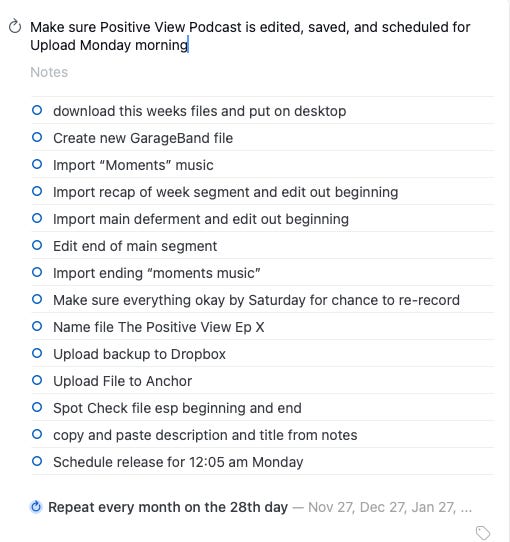Pilots Use this Tool and You Can, Too!
If you're putting off a recurring task like I am, check this out.
Think of the task that you need to do regularly that you always put off.
It could be an errand, a project, a workout routine, or a Substack newsletter. (Oh look! The inspiration for this post.)
How do you feel when you think about getting started on this task?
When you see it on your “To do” list or it pops into your head, do you immediately think, “I’ll do it later?”
Or worse …
Do you get what I call “The Dread?”
You know the one. Your brain is avoiding doing the task, but you can’t enjoy goofing off because the task is there. Hovering in the nebulous future … going undone … gaining more dread.
What’s the problem?
The problem is you don’t have a single task. You’ve got a project, and you’re treating it like a single task.
And how do you solve this problem?
Whenever you have trouble, to paraphrase Nike, “Just doing it,” you need to separate planning from execution. And if you’ve got a recurring task that keeps going undone and is late, then it’s time to ….
Pilots! Before You Start Your Engines
Fuel pressure - Check
Oil pressure - Check
Flaps: Check
Yup! I’m talking about a checklist.
And they are so powerful they save lives. You can read more about it, in Atul Gawande’s book, The Checklist Manifesto: How to Get Things Right.
I’ve found that this handy little tool not only helps me to not forget vital steps in a project, but it also helps me complete the project. It’s hard to leave that last box or two unchecked.
Breaking down a task into smaller, doable parts allows you to focus on just one small thing and not worry about what’s next. You save the brain power needed to think of each step that you can use for executing on the task at hand.
Larger projects, can be divided into multiple parts, which can be done in smaller chunks of time making it easier to schedule.
Plus, there’s the bonus of having it all written down, which allows for easier outsourcing and delegation.
When to use and create a checklist
If you’re staring at a giant nebulous item on your “To Do” list and needing to block off a “bunch” of time to cross it off leads to procrastination.
Recurring chores
Self-care tasks
I’ll give you an example of one of my checklists.
The podcast I host with my friend, Briana, comes out on the first Monday of the month. To keep me from procrastinating, I created a checklist in my Things3 app that automatically shows up the last week of the month.
I also have other forms of checklists such as my self-care checklist.
This list drops into my calendar daily, but I have the option of doing just one, some, or all of the things on the list.
Side note: I love my Things3 app (this isn’t sponsored). It allows me to list all my To Do’s for a day, keep notes on what I need, and then also add checklists to the regular tasks. It syncs with all my devices (watch, desktop, iPad, and phone), and I paid a onetime fee for it. No subscription.
Of course, you can kick it old school with a printed piece of paper, use a spreadsheet or use an app of your choice.
Can you checklist your whole life?
Yes!
I’ve been revising and re-working my spreadsheet to help me keep up with all my tasks. It allows me to make one big habit of all my habits, and I don’t expect to get 100% of it done. But it calculates the percentage of stuff I’ve done, which gives me an opportunity to troubleshoot and streamline.
Naturally, it’s the overview of what I do daily, and I have my individual project lists elsewhere. It’s a bit large, but here’s a screenshot. (Look at all those substack posts that don’t have checkmarks. Yikes! )
Every other week, I go over it with my mental health nurse practitioner that assists me with managing my ADHD. It amazes me how something so simple coupled with regular accountability has changed my life.
It’s one of the key tools that’s helped me
Lose 20 lbs, complete my first half marathon
Reconnect with old friends, prioritize visiting my family
Get my blood sugar into normal range
Meditate daily
Journal daily
and way more.
That looks cool, but it looks like a lot of work to setup
If you’re a spreadsheet whiz, you can probably set one up pretty easily. I’m not, but because I did it in stages with my NP, it wasn’t as hard as I though it would be.
Plus, you don’t need a complicated checklist for your whole life to start. You can do shorter ones in Word, Google docs, or even write one freehand and copy it.
While it did take some time to put together at first, now it only takes a few minutes a day to use. Each month I take about a half an hour to revise my list for the next month.
If you’d like to create a customized master spreadsheet like mine and want to avoid the hard work of creating it on your own, book a 1-on-1 session with me.
Paid subscribers get $25 off (see code below).
Annual subscribers get a free half-hour session.
I’m working on next year’s goals and spreadsheet now.
But first, I need to put together a checklist for writing this newsletter.
P.S. As promised, here’s the $25 OFF discount code for Paid Subscribers
Keep reading with a 7-day free trial
Subscribe to The ART of Personal Transformation to keep reading this post and get 7 days of free access to the full post archives.





